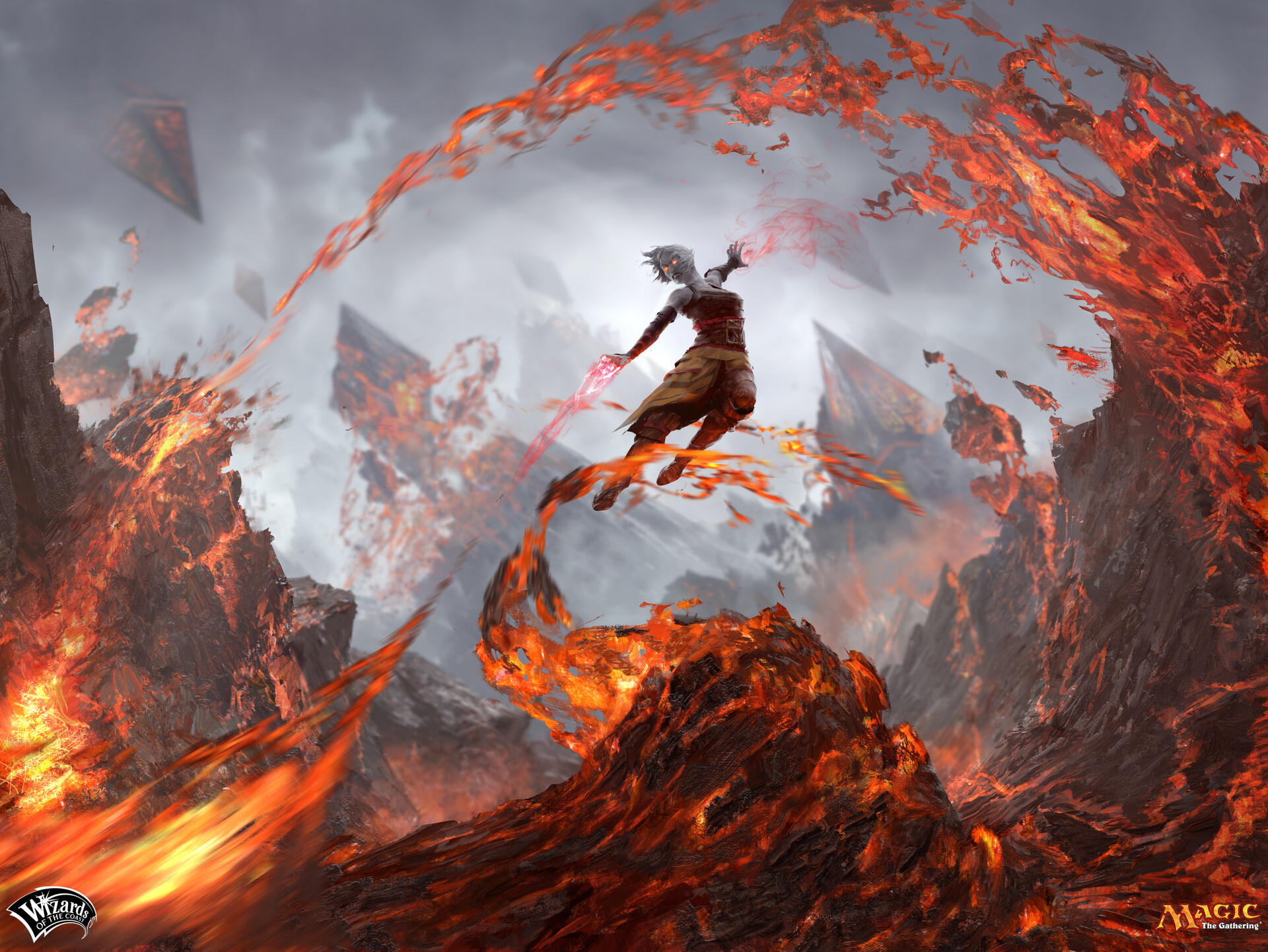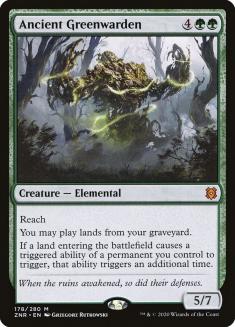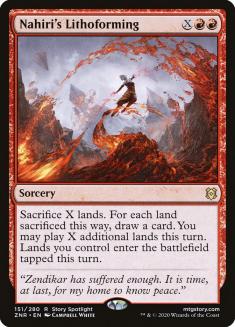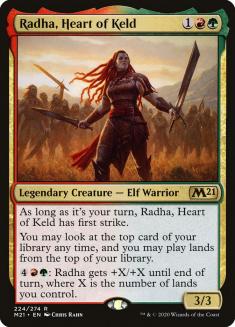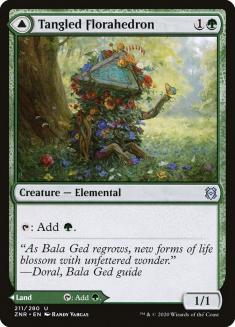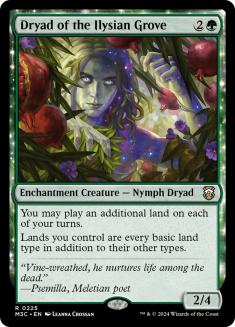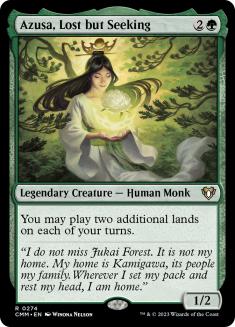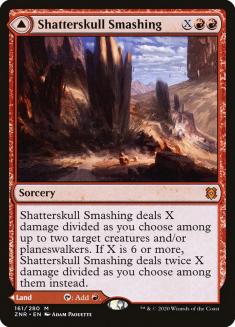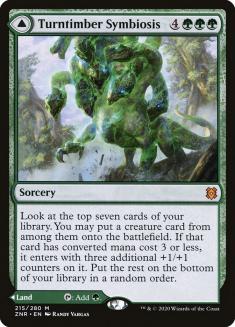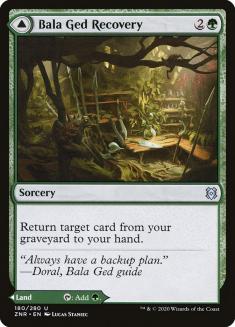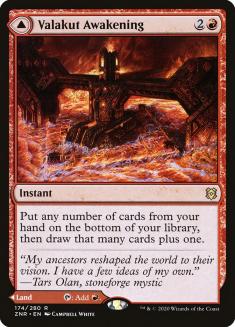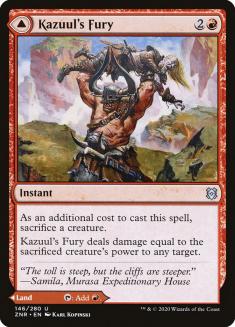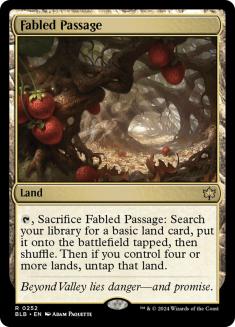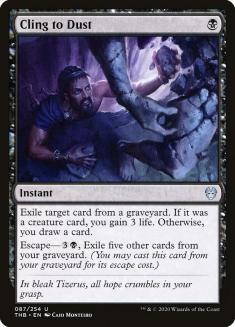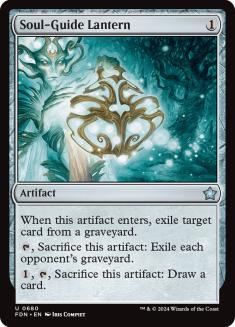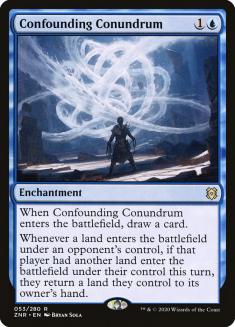The father of Deconstructionism, Jacques Derrida, famously said (after translation), “I have only one language and it is not my own.” The value of words, maybe more so than ever, is fleeting. So when a Magic player calls a deck “broken,” it behooves us to take on a thorough exploration of exactly what idea they are trying to express. In this essay, I will…
What’s that?
Nobody cares and they just want to see the absurdly powerful pile of wizarding squares? Ah. Well… here you go then.
Creatures (20)
- 1 Azusa, Lost but Seeking
- 4 Lotus Cobra
- 4 Dryad of the Ilysian Grove
- 3 Radha, Heart of Keld
- 4 Tangled Florahedron
- 4 Ancient Greenwarden
Lands (20)
Spells (20)

I’ve been building Magic decks for a long time. I’ve even produced a format-definer or two (bracketed by many, many less impressive takes). Despite that, I think this is the best deck I’ve ever built from just a pure cogency and proof-of-concept standpoint.
Note that I have zero idea how this translates into real-world performance. I’m stuck waiting for Zendikar Rising’s Magic Arena release just like everyone else, and I don’t have the luxury of having a dedicated and safe space to jam games like my friends over on VS Live! And let me tell you, this fact is killing me. I am dying to put this deck through its paces and figure out just what it’s capable of. Let’s talk about the reasons I’m excited about this deck in a way that I haven’t felt since I first combined Necrotic Ooze with Survival of the Fittest.
First, some threshold knowledge you need to possess to understand what is going on here. For some reason, you can play modal double-faced cards (DFCs) as lands from your library with Radha, Heart of Keld. You can do the same thing from your graveyard with Ancient Greenwarden. Please don’t ask me to explain why, but if you don’t want to take my word for it, here’s a thread from the set’s lead designer with a bunch of high-level judges weighing in throughout.
Once you know this, you get to unravel the cosmic beauty that is casting a Nahiri’s Lithoforming with an Ancient Greenwarden and a Lotus Cobra on the battlefield. Congrats, you now have an excellent chance of drawing as much of your deck as you want and killing your opponent on the spot.
Let’s assume things have gone well for you. You cast a Lotus Cobra on Turn 2. It lived, and you used it with a Fabled Passage on Turn 4 to cast an Ancient Greenwarden. Now Turn 5 has rolled around. You play your fifth land, generate two mana due to Ancient Greenwarden supercharging your Lotus Cobra, and cast a Nahiri’s Lithoforming with X=5.
You’ve picked up five new cards, but you also get to play all five lands that you just sacrificed from your graveyard with Greenwarden. Add any further Lotus Cobras you’ve drawn to the mix, but you’re producing a minimum of ten mana with the first Lotus Cobra. That’s enough to pick up your first Nahiri’s Lithoforming with Bala Ged Recovery, cast a second one you’ve drawn, or use Valakut Awakening to spin your now-swelling hand into a new one to look for another Lithoforming.
Do it again, and the train keeps rolling, slowly adding more Cobras and other various land-drop-generating creatures to the mix. At some point you’ll have a surplus of mana that you can dump into Radha, Heart of Keld. Find your one-of Kazuul’s Fury – it doesn’t matter if you played it as a land, as you can sacrifice it with Lithoforming and buy it back with Bala Ged Recovery – and throw Radha at your opponent’s face while they wonder what just happened.
If you allow me to basically set the top of my deck, I can do this on Turn 4 (maybe Turn 3 is theoretically possible, but it’s thin enough that there’s no reason to really figure it out). It’s far more reasonable that you achieve this on Turn 5. Even with a pretty compact package of respectable cards, I’d have very little interest in a three-card Turn 5 combo if it were the entirety of what this deck had to hang its hat on. This is only the beginning of a long list of selling points.
The standout features of this deck are redundancy and consistency. There are multiple ways to both search for and rebuy key cards. The card advantage engines are legit and amplified by the way the deck is built. Beyond that, you get the almost unfathomable pleasure of playing a deck with 40 (yes, 40) lands. Remember how it feels to miss your third land drop? Not anymore you don’t.
Most importantly, you just don’t need to achieve your combo. At all. Without putting together these cards, you are a respectable Gruul midrange deck, and you can lean even further towards the midrange side of the equation after sideboarding. This kind of flexibility is the hallmark of a format-definer. Twinblade, Jeskai Lukka, Aetherworks Marvel… the list is long.
Let’s do the card-by-card breakdown thing:
The cards that make any of this possible, and the ones that triggered the alarm bells that pushed me to build this deck. If you’ve consumed any of my content over the past few weeks, you know I am extremely high on the modal DFCs. This deck began as a simple thought experiment. I just wanted to see how high you could realistically push your land counts. Obviously, you can play 60 lands, but you need to find some benefit to doing so.
One of the clear beneficiaries of such extreme land density was Radha, Heart of Keld. From there, I looked for ways to mess with my library, and realized that if I made Nahiri’s Lithoforming’s extra land drops via Radha, Heart of Keld, then the cards I had drawn would become pure card advantage. Thinking I was on to something powerful, I began searching for redundancy, and Ancient Greenwarden became the piece that kicked everything into high gear.
Lithoforming is the reason I see 40 lands as the baseline requirement for this deck in Game 1. I don’t want to ever fear cycling the card to fuel future Greenwardens and find key pieces, and I need to be confident I will be able to make up for my sacrificed lands.
Both Ancient Greenwarden and Radha are respectable cards on their own. Radha has never had the benefit of 40 hits before, and it’s hard to think of many other contexts where it will again. I also feel like people are sleeping on a 5/7 with reach that functions as a persistent and immediate source of card advantage. Don’t forget that we naturally load up our graveyard with lands by playing our spells. You’re also going to win games just by attacking with your big bodies. That’s what makes the threat of a combo kill so troubling.
While what we are doing is inherently powerful, we’re not exactly overflowing with catch-up options. It’s important we play ahead of curve. Lotus Cobra was always going to make the cut for its combo implications, but I’m a huge believer in Tangled Florahedron across multiple archetypes. Faster Greenwardens are a big game, and the fact that Florahedron can provide them without sacrificing our land density is something that just shouldn’t be possible. Overlaps like this in functionality and plans are why I think this is the best deck I’ve ever built. Everything just fits and makes sense.
I put 40 lands in my deck, so I wanted ways to make extra land drops. Big-brained stuff, right? To me, Dryad of the Ilysian Grove is the clear choice among these two cards. The 2/4 body is just critical to your defensive efforts, and it even improves some of your dodgier lands. I would play more copies if I could, hence, Azusa, Lost but Seeking.
Again, given the surrounding context, these cards push Radha and Ancient Greenwarden to absurd heights. The package generates meaningful card advantage that will simultaneously accelerate us to our end-game. We couldn’t realistically call ourselves a midrange deck without access to Dryad, as it enables our primary mode of interaction.
Our aforementioned primary mode of interaction. I think Shatterskull Smashing rates pretty low on the power scale for the mythic modal DFCs, but it’s still a mythic modal DFC. We want as many lands as possible in our deck anyway and will benefit from having a way to answer problematic creatures on our opponent’s side of the battlefield. We are also one of the few decks that will reliably hit the mana thresholds necessary to make Shatterskull Smashing a powerful card.
Here’s where the deck picks up its redundancy, and it feels silly saying it again, but yeah, also a bunch of lands. Turntimber Symbiosis finds our main combo pieces when we’re searching. Obviously, we’re happy to pay seven mana to find a Greenwarden (that can immediately put Turntimber Symbiosis onto the battlefield as a land!), but I think Dryad of the Ilysian Grove as a 5/7 and Radha, Heart of Keld as a 6/6 are going to represent solid deals a lot of the time as well. And if a 5/4 Lotus Cobra is just going to immediately win me the game, I’m not mad at it either.
Hypergeometric calculation suggests that with twenty hits we’ll find something 95% of the time, and even if you want to limit meaningful hits to eleven – Radha, Greenwarden, and Dryad of the Ilysian Grove – we’re still looking at a 77% success rate. That’s good enough for me, and is also providing some nice complaint equity for the times you do miss.
Bala Ged Recovery has been all over any green midrange deck I’ve built, but when it’s also picking up combo pieces, it just hits differently. I’m sure you’ll pickup Shatterskull Smashing to wipe your opponents battlefield as often as you’ll pick up Nahiri’s Lithoforming when comboing off, but having more copies of everything is exactly what this deck needs.
Valakut Awakening is the most linear and therefore probably the worst card in this deck. If the worst card in your deck reminds you of cards like Windfall and Wheel of Fortune — cards that have occupied spots on Eternal banned lists for years — you’re probably in a pretty good position. This is only optimal when you are comboing off, but with multiple ways to make land drops from places other than your hand, Valakut Awakening is going to get far deeper into your library than it would in most other decks even in fair spots. It’s what makes a well-set-up Lithoforming almost certain to be lethal, but maybe it’s worse than Bala Ged Recovery and their numbers should be reversed?
Do you have to kill your opponent after you have drawn your deck and put all of your creatures on the battlefield? Probably not. Should you if it costs you almost nothing to do so? Absolutely.
These seem like the two lands which merit some additional discussion. Fabled Passage is obviously a superstar alongside Lotus Cobra and Ancient Greenwarden (and to a lesser extent, Radha) but I found myself concerned about both running out of basics and the number of untapped green and red lands I had access to on Turns 1-3. With no one-drops to cast, maybe this fear is just overblown, and I end up with the fourth copy once I start playing.
When it comes to Radiant Fountain, this card is actually a critical part of your plan against aggressive decks. It’s unlikely you’d ever get a Lotus Cobra to survive against something like Mono-Red, so instead your goal is to use extra land drops from Dryad of the Ilysian Grove to ramp to Ancient Greenwarden and then use Nahiri’s Lithoforming to move Radiant Fountains across zones for four life a pop.
This plan strikes me as extremely solid, but it must rely on naturally drawing Radiant Fountains. Unfortunately, those Fountains are apt to be blank in a bunch of other matchups, and the colorless mana could really stifle our progression. For now, I’ve contented myself with playing an additional copy in the sideboard, but I’ll be watching carefully to see if I can justify playing more Fountains main.
As far as what I’m not playing, the card I’ve been asked the most about is Kazandu Mammoth. Quite frankly, I don’t get it. It doesn’t seem to contribute to either of the core plans and disrupts the perfect overlap the deck currently presents. Maybe it opens up extra Kazuul’s Fury kills, but it’s hard to see that being the case unless thing are going very well, and Kazandu Mammoth doesn’t contribute at all to things going well. I think the card is strong in the abstract, but sometimes that’s not enough to secure a spot in a deck. Maybe it ends up part of transitional sideboard plans, or the deck benefits from doing some very disparate things. For now though, I’m unconvinced.
The card I really wanted to fit in here was Gilded Goose. I think casting either Radha or Dryad of the Ilysian Grove on Turn 2 is an incredible boost, and Goose making Food is a fine mana sink on inefficient turns. I just can’t shake the feeling that I have to play 40 lands to maximize my synergies though, and Goose is not better than any of the nonland options I’m presently playing. In addition, we’re low-ish on untapped Turn 1 green sources. I’m still open to the idea the Gilded Goose deserves a slot here, but I’ll see if we can keep pace without it for the time being.
When it comes to the sideboard, the vast majority of my focus is on keeping aggressive decks at bay. Kazandu Nectarpot and a nice set of removal spells let the “get to Ancient Greenwarden” goal be achieved easily, and now every land in our deck gets to do a Radiant Fountain impression. May as well pick up an extra copy of Fountain as well. Lotus Cobra and Valakut Awakening are the first cards on the chopping block here.
Valakut Exploration is my plan against the decks that will try to answer my cards on a one-for-one basis with disruption or countermagic. Eventually, the card quantity should overwhelm them, and if not, maybe the persistent damage will. I would probably trim the combo here, and might look to diversify my big threat by bringing in Phylath, World Sculptor. It’s in Phylath’s slot that I could potentially see the appeal of having Kazandu Mammoth instead, but it just feels a little too small-ball.
A few words on potential hate cards.
Ha. LOL. Come on.
If you choose to target my graveyard, I will just kill you in other ways. That is the benefit of having a combo deck that is happy playing in multiple fashions. The fact that the graveyard hate is all pretty soft makes the problem even worse. Pop Soul-Guide Lantern after I cast Lithoforming and I can just play lands from my hand and cast another Lithoforming. These are speed bumps, not answers.
Then we have the ultimate speed bump: Confounding Conundrum. If your opponent casts Confounding Conundrum against you, you can now go infinite with your combo. That’s right, their hate card opens up new combo lines.

It involves Bala Ged Recovery and Nahiri’s Lithoforming looping themselves along side Greenwarden and Lotus Cobra. Basically you get to play the flipside of Bala Ged Recovery from your graveyard as a land. Confounding Conundrum returns it to your hand and you then use the front side to rebuy the Lithoforming. This nets mana if X is high enough and it’s all very silly. I have no idea how much it’s actually going to come up (or if you can do it in a timely fashion on Arena), but it’s a clear illustration of just how “soft” Confounding Conundrum really is. It’ll slow you down a bit, but everyone is slower in sideboard games, and you’re equipped to function just fine going long.
I hope this breakdown has you as excited for this deck as I am. Again, there are plenty of things that can go wrong here. The format might break in completely unexpected ways, or maybe I’m just off base and this is nowhere near as explosive or consistent as I think it is.
Either way, I’m confident that the worst-case scenario is that this concept is something worth iterating on. The combinations here are too powerful, and too elegant to completely miss Constructed play. Get in on the ground floor.

